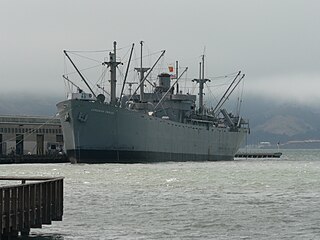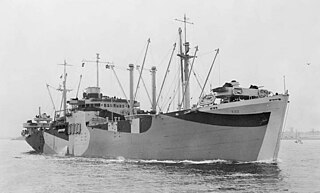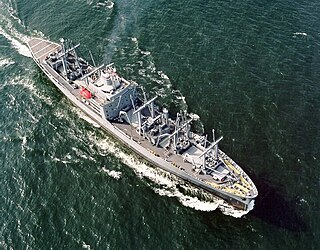Auriga or AURIGA can refer to:

A steamship, often referred to as a steamer, is a type of steam-powered vessel, typically ocean-faring and seaworthy, that is propelled by one or more steam engines that typically move (turn) propellers or paddlewheels. The first steamships came into practical usage during the early 1800s; however, there were exceptions that came before. Steamships usually use the prefix designations of "PS" for paddle steamer or "SS" for screw steamer. As paddle steamers became less common, "SS" is assumed by many to stand for "steamship". Ships powered by internal combustion engines use a prefix such as "MV" for motor vessel, so it is not correct to use "SS" for most modern vessels.

Liberty ships were a class of cargo ship built in the United States during World War II. Though British in concept, the design was adopted by the United States for its simple, low-cost construction. Mass-produced on an unprecedented scale, the Liberty ship came to symbolize U.S. wartime industrial output.

Auriga is one of the 88 modern constellations; it was among the 48 constellations listed by the 2nd-century astronomer Ptolemy. It is north of the celestial equator. Its name is Latin for “(the) charioteer”, associating it with various mythological beings, including Erichthonius and Myrtilus. Auriga is most prominent during winter evenings in the northern Hemisphere, as are five other constellations that have stars in the Winter Hexagon asterism. Because of its northern declination, Auriga is only visible in its entirety as far as 34° south; for observers farther south it lies partially or fully below the horizon. A large constellation, with an area of 657 square degrees, it is half the size of the largest, Hydra.

Alien Resurrection is a 1997 American science fiction horror film directed by Jean-Pierre Jeunet, written by Joss Whedon, and starring Sigourney Weaver and Winona Ryder. It is the fourth installment of the Alien film series and the final installment in the main series. It was filmed at the 20th Century Fox studios in Los Angeles, California.

An ocean liner is a passenger ship primarily used as a form of transportation across seas or oceans. Liners may also carry cargo or mail, and may sometimes be used for other purposes.

SS Jeremiah O'Brien is a Liberty ship built during World War II and named after the American Revolutionary War ship captain Jeremiah O'Brien (1744–1818).

SS United States is a retired ocean liner built in 1950–51 for the United States Lines at a cost of $79.4 million. The ship is the largest ocean liner constructed entirely in the United States and the fastest ocean liner to cross the Atlantic in either direction, retaining the Blue Riband for the highest average speed since her maiden voyage in 1952. She was designed by American naval architect William Francis Gibbs and could be converted into a troopship if required by the Navy in time of war. The United States maintained an uninterrupted schedule of transatlantic passenger service until 1969 and was never used as a troopship.

Type C1 was a designation for small cargo ships built for the United States Maritime Commission before and during World War II. The first C1 types were the smallest of the three original Maritime Commission designs, meant for shorter routes where high speed and capacity were less important. Only a handful were delivered prior to Pearl Harbor. But many C1-A and C1-B ships were already in the works and were delivered during 1942. Many were converted to military purposes including troop transports during the war.

HMS Auriga (P419), was an Amphion-class submarine of the Royal Navy, built by Vickers Armstrong and launched 29 March 1945.

MS Birger Jarl is a cruise ship owned by Ånedin Linjen that was operated on services between Stockholm, Sweden and Helsinki, Turku and most recently Mariehamn on the Åland Islands (Finland). She was built in 1953 as a passenger liner at Finnboda shipyard in Nacka, Sweden as SS Birger Jarl for Rederi AB Svea. In 1973 she was sold to Jakob Lines, was renamed SS Bore Nord and converted into a ferry. In 1978 she was bought back by the Ånedin Line and was renamed SS Baltic Star. In 1982 the ship's original steam engines were replaced by diesel engines; the ship's prefix hence altered to MS. In 1989 the engines were again replaced by new diesels. In 2002 the ship reverted to the name Birger Jarl.

USS Auriga (AK-98) was an Auriga-class cargo ship commissioned by the U.S. Navy for service in World War II, named after the constellation Auriga. She was responsible for delivering troops, goods and equipment to locations in the war zone.

NGC 1931, is an emission and reflection nebula in the constellation Auriga. The nebula has been referred to as a "miniature version of the Orion Nebula", as it shares some of the same characteristics. It is a mixed emission-reflection nebula, and contains a smaller version of the Trapezium in its hot young star cluster centered in the emission nebula. The entire cluster/nebula complex is only about 3 arcmin in size. The distance from earth is estimated at about 7000 light years.

The SS Chesapeake is a transport oiler that was in service with the United States Navy from 2000 to 2009. She was operated by Military Sealift Command.

SS Capella is an Algol class vehicle cargo ship that is currently maintained by the United States Maritime Administration as part of the Military Sealift Command's Ready Reserve Force (RRF). She was built as a high speed container ship by Rotterdamsche D.D.Mij N.V. in Rotterdam, Netherlands, hull no. 330, for Sea-Land Service, Inc. and named SS Sea-Land McLean, USCG ON 540413, IMO 7223508, after Sea-Land's founder Malcom McLean. Due to her high operating cost, she was sold to the United States Navy on 16 April 1982 as USNS Capella (T-AK-293).

SS Beaver State (T-ACS-10) is a crane ship in ready reserve for the United States Navy. The ship was named for the state of Oregon, which is also known as the Beaver State.

The SS Cape Jacob is a steam turbine-driven ship, first launched as the SS California. It was to be used by the Maritime Administration, and was delivered in 1962 and put under contract to the States Steamship company. The ship was later transferred to the Military Sealift Command, and put into reserve status temporarily. It was then transferred to active duty as a prepositioning ship.

SS Cape Gibson (AK-5051) is a Cape G Class Break bulk cargo ship of the United States Maritime Administration, last used as a training ship at Texas A&M University at Galveston. Currently she is mothballed in the Beaumont Reserve Fleet.
SS Ruahine was a passenger ship that operated during the 20th century, primarily in line service between Great Britain and New Zealand for the New Zealand Shipping Company.
Auriga was a Hansa A Type cargo ship which was built as Adamsturm in 1944 by Deutsche Werft, Hamburg, Germany for Deutsche Dampfschifffarts-Gesellschaft Hansa, Bremen Germamy. She was seized as a prize of war in 1945, passing to the Ministry of War Transport and renamed Empire Gantry. She was sold in 1947 and was renamed Baltanglia. She was renamed Baltic Pine in 1952. Sold to Greece in 1954, and renamed Germania, she was declared a constructive total loss following a collision in 1955. Sold to Germany, she was repaired and renamed Auriga. She served until 1965, when she was scrapped.
















